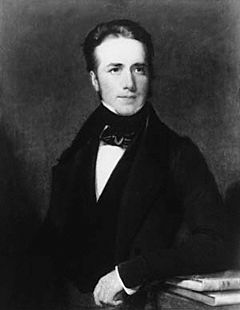Thomas Drummond facts for kids
Quick facts for kids
Thomas Drummond
|
|
|---|---|

c. 1838 by Henry William Pickersgill
|
|
| Born | 10 October 1797 Edinburgh, Scotland
|
| Died | 15 April 1840 (aged 42) |
| Resting place | Ireland |
| Occupation | Civil engineer |
| Known for | Cartography Drummond lamp |
| Spouse(s) | Maria Kinnaird |
| Children | three daughters |
| Signature | |
Captain Thomas Drummond (born October 10, 1797 – died April 15, 1840) was an important Scottish army officer and engineer. He also worked as a senior government official. He was known for using the Drummond light (also called limelight) in big land surveys. These surveys mapped out Great Britain and Ireland. While he didn't invent limelight, he was the first to see how useful it could be for mapping.
Contents
Thomas Drummond's Early Life
Thomas Drummond was the second of three brothers. His father passed away when Thomas was young. He always said his mother helped him a lot with his schooling. He went to Edinburgh High School. Later, in 1813, he became a cadet at Woolwich Academy to train as a Royal Engineer.
Thomas was very good at mathematics from a young age. After his training, he worked in Edinburgh on public projects. He found this work a bit boring. He was about to start studying law when he got a new job. He was asked to use his math skills to help with a land survey in the Scottish Highlands.
Learning New Things
Thomas worked on the survey during the summer months. In the colder months, he spent time in London. He used this time to learn even more about math and science. He went to lectures by a famous scientist named Sir Michael Faraday. It was at these lectures that Thomas learned about a new invention called limelight.
Mapping Ireland: The Ordnance Survey
In 1824, Thomas Drummond was moved to a new project. This was the Ordnance Survey of Ireland. Here, he put the new Drummond light to good use. He found that the light was incredibly powerful. He reported that people could see the light from 68 miles away! It was so bright that it could even cast a strong shadow from 13 miles away.
Thomas left Ireland for a short time before 1832. He helped a political group called the Whigs. Because of his help, he was given a yearly payment of 300 pounds.
Family Life
In 1835, Thomas Drummond returned to the Irish Survey. He married a wealthy woman named Maria Kinnaird. Maria was the adopted daughter of a well-known critic. Thomas and Maria had three daughters: Emily, Mary, and Fanny.
Leading the Government in Ireland
After his work on the survey, Thomas Drummond was given a very important job. He became the Irish Under-Secretary. This meant he was in charge of the government administration in Dublin Castle. He held this position from 1835 until he passed away in 1840.
Thomas was a supporter of the Whigs, a political group. People in Ireland respected him greatly. He treated everyone fairly, no matter their background.
Thomas Drummond's Legacy
Thomas Drummond passed away in 1840. He was buried in Mount Jerome Cemetery in Dublin. His family doctor believed he got very sick. Many people think that working so hard and the stress of his job led to his early death. He had worked tirelessly for five years as the Irish Under-Secretary.
His last reported words showed how much he loved Ireland:
"I wish to be buried in Ireland, the country of my adoption a country which I loved, which I have faithfully served, and for which I believe I have sacrificed my life."
Thomas Drummond also spoke out about the system of very large estates in Ireland. He famously said, "Property has its duties as well as its rights." This meant that people who owned a lot of land also had responsibilities to the people living on it.
See also
- Timeline of hydrogen technologies

